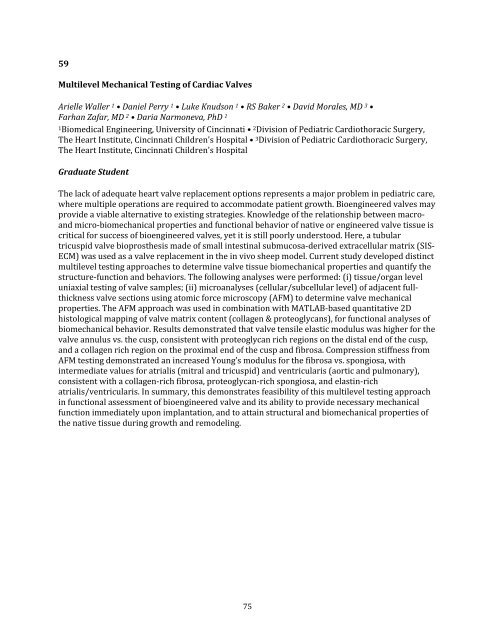2017 Cardiovascular Research Day Abstract Book
Create successful ePaper yourself
Turn your PDF publications into a flip-book with our unique Google optimized e-Paper software.
59<br />
Multilevel Mechanical Testing of Cardiac Valves<br />
Arielle Waller 1 • Daniel Perry 1 • Luke Knudson 1 • RS Baker 2 • David Morales, MD 3 •<br />
Farhan Zafar, MD 2 • Daria Narmoneva, PhD 1<br />
1Biomedical Engineering, University of Cincinnati • 2 Division of Pediatric Cardiothoracic Surgery,<br />
The Heart Institute, Cincinnati Children's Hospital • 3 Division of Pediatric Cardiothoracic Surgery,<br />
The Heart Institute, Cincinnati Children's Hospital<br />
Graduate Student<br />
The lack of adequate heart valve replacement options represents a major problem in pediatric care,<br />
where multiple operations are required to accommodate patient growth. Bioengineered valves may<br />
provide a viable alternative to existing strategies. Knowledge of the relationship between macroand<br />
micro-biomechanical properties and functional behavior of native or engineered valve tissue is<br />
critical for success of bioengineered valves, yet it is still poorly understood. Here, a tubular<br />
tricuspid valve bioprosthesis made of small intestinal submucosa-derived extracellular matrix (SIS-<br />
ECM) was used as a valve replacement in the in vivo sheep model. Current study developed distinct<br />
multilevel testing approaches to determine valve tissue biomechanical properties and quantify the<br />
structure-function and behaviors. The following analyses were performed: (i) tissue/organ level<br />
uniaxial testing of valve samples; (ii) microanalyses (cellular/subcellular level) of adjacent fullthickness<br />
valve sections using atomic force microscopy (AFM) to determine valve mechanical<br />
properties. The AFM approach was used in combination with MATLAB-based quantitative 2D<br />
histological mapping of valve matrix content (collagen & proteoglycans), for functional analyses of<br />
biomechanical behavior. Results demonstrated that valve tensile elastic modulus was higher for the<br />
valve annulus vs. the cusp, consistent with proteoglycan rich regions on the distal end of the cusp,<br />
and a collagen rich region on the proximal end of the cusp and fibrosa. Compression stiffness from<br />
AFM testing demonstrated an increased Young’s modulus for the fibrosa vs. spongiosa, with<br />
intermediate values for atrialis (mitral and tricuspid) and ventricularis (aortic and pulmonary),<br />
consistent with a collagen-rich fibrosa, proteoglycan-rich spongiosa, and elastin-rich<br />
atrialis/ventricularis. In summary, this demonstrates feasibility of this multilevel testing approach<br />
in functional assessment of bioengineered valve and its ability to provide necessary mechanical<br />
function immediately upon implantation, and to attain structural and biomechanical properties of<br />
the native tissue during growth and remodeling.<br />
75


